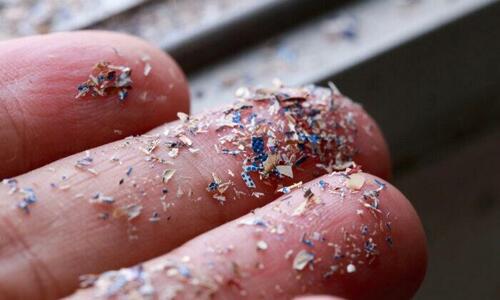Microplastics Found In Human Testicles
Authored by Amie Dahnke via The Epoch Times (emphasis ours),
Microplastics have been identified in human and canine testicles, lengthening the list of where the insidious particles have been found.
Not testicles. (iStock/Getty Images Plus)
A new study published in Toxicological Sciences revealed the incredible prevalence of microplastics worldwide and their ability to penetrate nearly every part of the body.
Microplastics form when plastic is exposed to sunlight or other ultraviolet radiation and slowly degrades in landfills, the ocean, or other places. They are so small (measured in micro- or nanometers, or a billionth of a meter) that they can also be blown around by the wind and carried into waterways.
Human Samples Had Triple the Microplastics
A team of researchers at the University of New Mexico (UNM) examined testicular tissue samples from humans and dogs and found these microscopic pieces of plastic were present in every sample. The human samples were supplied by the New Mexico Office of the Medical Investigator, which collects tissues during autopsies, and the canine samples came from the City of Albuquerque animal shelters and private veterinary clinics that spay and neuter animals.
The researchers didn’t expect to find microplastics in the reproductive system—at least, not to this degree.
“When I first received the results for dogs I was surprised,” Dr. Xiaozhong “John” Yu, a professor at the UNM College of Nursing and lead researcher, said in a press release. “I was even more surprised when I received the results for humans.”
The research team found nearly three times the amount of microplastics in the human samples compared to the canine samples. There were 122.63 micrograms of microplastics per gram of tissue in the canine samples and 329.44 micrograms per gram in the human.
The team found 12 types of microplastics in 47 canine samples and 23 human samples. The most prevalent polymer, or plastic, in both types of tissue was polyethylene (PE), which is used to make plastic bags and bottles. The next most common polymer in dogs was PVC, which is often used in different kinds of plumbing.
Dr. Yu and his team believe that the level of microplastics could correlate with reproductive issues. The team determined the sperm count in the canine samples and found that the higher the level of PVC in the tissue, the lower the sperm count was. However, the correlation was not found with the concentration of PE in tissue.
“The plastic makes a difference—what type of plastic might be correlated with potential function,” Dr. Yu said. “PVC can release a lot of chemicals that interfere with spermatogenesis and it contains chemicals that cause endocrine disruption.”
Why Dogs?
The study compared dogs and humans because the two often share an environment, as well as some biological characteristics.
“Compared to rats and other animals, dogs are closer to humans,” Dr. Yu said.
He noted that dogs and humans produce sperm in very similar ways and that the sperm concentration is also comparable between the two species.
“We believe dogs and humans share common environmental factors that contribute to their decline,” he said.
One of those environmental factors is microplastics, which are found worldwide, including on the top of Mt. Everest.
“The impact on the younger generation might be more concerning,” Dr. Yu said, pointing to men 35 years old and younger. “We have a lot of unknowns. We need to really look at what the potential long-term effect [sic]. Are microplastics one of the factors contributing to this decline?”
Dr. Yu added that, while he doesn’t want to scare anyone, he thinks it is important to make people aware that their choices have consequences.
“We want to scientifically provide the data and make people aware there are a lot of microplastics. We can make our own choices to better avoid exposures, change our lifestyle and change our behavior,” he said.
Tyler Durden
Tue, 05/21/2024 – 19:40




Share This Article
Choose Your Platform: Facebook Twitter Linkedin